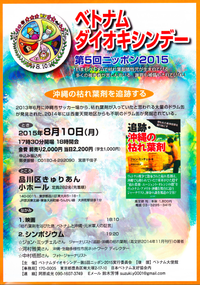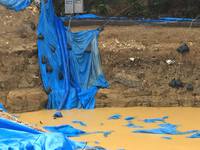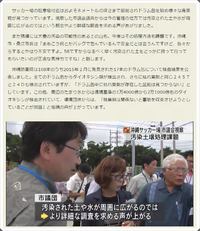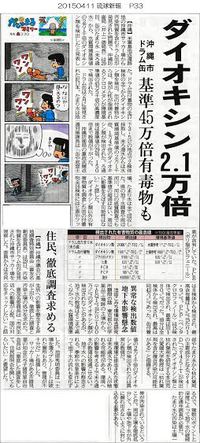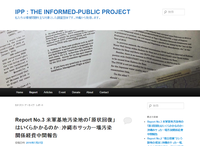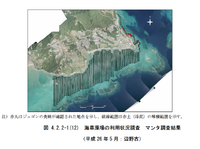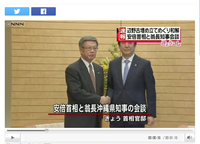枯れ葉剤:沖縄県との交渉を退役軍人にレポートしました
2012年06月20日/ 枯れ葉剤
沖縄の枯れ葉剤問題では、退役兵と沖縄の人々、ジャーナリスト、地元メディアが、現在ゆるやかなつながりを持ち始めています。 沖縄からの発信を行っているOkinawa Outreachは、退役兵とFacebookのAgent Orange Okinawaで、情報交換をしています。
これまでも、沖縄の動きの報告などは折につけ、していたのですが、6月1日の沖縄BDの沖縄県との枯れ葉剤に関する交渉については、退役軍人たちへのまとまった報告が必要と考えたことと、多くの人に日本政府と沖縄県の対応を知ってもらいたいということで、Okinawa Outreachが英語の記事をつくりました(テキストのみ下に貼り付け)。
記事はこちら→Okinawa Outreach "Okinawa NGO discusses with Okinawa Prefecture over Agent Orange" (2012.6.12)
この記事をAgent Orange Okinawaのグループにポストしたところ、退役軍人から以下のようなコメントがありました。
また、Okinawa Outreachの記事をジョン・ミッチェルがジャパン・フォーカスの記事で引用し、沖縄の動きを伝えてくれました。
Jon Mitchell, "Agent Orange at Okinawa's Futenma Base in '80s: U.S. vet nearby residents possibly tainted by leaking barrels, poisoned water table," The Asia-Pacific Journal, Vol 10, Issue 25, No. 3, June 18, 2012.
退役軍人に報告したこと、退役軍人からのコメント、ジャパン・フォーカスの記事の件を、県が、退役軍人の証言を大切にし、彼/彼女らに一日も早く応えてくれることを願い、沖縄県にFAXで伝えました。 沖縄県の環境、県民の健康、安全だけではなく、退役兵のいのちの問題であることを認識してもらいたいと思います。ジョン・ミッチェルがQABの番組で語っていたとおり、退役兵に時間は残されていないのですから。

以下、Okinawa Outreachの記事、テキスト部分のみの転載---------------------------
On June 1, 2012, Citizens' Network for Biodiversity in Okinawa(Okinawa BD) met with officials from the Okinawa prefectural government, discussing issues of Agent Orange in Okinawa. Here is Okinawa BD's report on the meeting.
Objectives for the meeting
Okinawa BD had two objectives for the meeting. The first one was to present to the prefectural government an evaluation report prepared by the Environmental Research Institute (ERI) in Tokyo. The report provides a critical evaluation on the Okinawa prefectural government’s handling of Agent Orange issues in Okinawa, and it also proposes a set of basic guidelines, which the prefectural government could adopt for future survey on AO in Okinawa. Okinawa BD had asked the ERI to prepare the report. The second one was to make inquiries about how the prefectural government has been addressing the issues of Agent Orange since we made formal requests for action to the prefectural government on October 26, 2011.
Answers from the Okinawa Prefectural Government
Main points of the prefectural government’s answers are as follows.
1) The Okinawa prefectural government has done nothing for AO issues and does not intend to pro-actively carry out their own investigation.
It was revealed that the Okinawa prefectural government has done nothing since Okinawa BD requested them in October 2011 to conduct their own investigation. Nor did they intend to do so for the time being. As reasons for their non-action, they claimed that if they “investigated blindly’ without identifying locations with “high probabilities” of being contaminated with AO, this could just create rumors harmful to the communities.
Okinawa BD reminded them that it’s the prefectural government’s responsibility to protect Okinawan people’s life, health and the environment and that the prefectural government has not fulfilled that responsibility. Okinawa BD again requested them to carry out fact-finding inquiries, including interview with former Okinawan US base workers and research on archive material in OKinawa, which can be done independently without relying upon or intervention from the US or Japanese government.
2) The Okinawa prefecture government did not present their own view/stance on AO issues; they reiterated the Japanese government’s view/stance.
Throughout the meeting, Okinawa BD asked the Okinawa prefectural government, in particular, Mr. Tome, Deputy Director General in charge of Military Base Affairs and Disaster Prevention, to provide the prefectural government’s own view/stance on issues of OA in Okinawa. Mr. Tome answered the question by keeping referring to the official view/stance held by the Japanese government.
First of all, Mr. Tome read aloud a statement provided to the prefectural government by the Japanese government. As we pointed out during the meeting, the statement Mr. Tome read was identical to the reply statement the Ministry of Foreign Affairs (MOFA) sent to the TV Asahi’s program “The Scoop”. The TV program requested the Japanese government to make comments regarding possible use/existence of AO in Okinawa. Mr. Tome was first appeared surprised by the fact they were identical, and then he acknowledged that the MOFA’s statement provided to the prefecture government had the same wording as the MOFA’s reply statement to the TV Asahi.
The statement contains paragraphs that discuss the Department of Veterans Affairs’ 1998 and 2008 decisions on veterans’ claims for being exposed to AO while serving in Okinawa. One of the paragraphs reads: “The VA’s decisions regarding the two cases, which are publically assessable, clearly states there were no reliable evidence for use of AO in Okinawa.”
As the TV Asahi uploaded the Japanesegovernment’s reply statement on its website, we were able to read and analyze it before our meeting with the Okinawa prefectural government. Thus, during the meeting, we were able to argue that the MOFA made a false interpretation about the VA’s decisions by taking out of context and emphasizing the wording of “kakushoteki shouko wa nai or “no verifiable evidence ” (this part roughly corresponds to the wording of “the service department experts have been unable to verify specific dioxin exposure in Okinawa” in the VA’s 1998 document (Okinawa BD have uploaded on its blog site our analysis regarding MOFA’s replay to TV Asahi).
Okinawa BD requested the prefectural government to go through the original VA documents by/for itself and to present their views on MOFA’s reply and the VA’s decisions soon.
Secondly, Mr. Tome repeated some parts of the Japanese government’s reply statement submitted in October 2011 in response to the letter of request “PromotingEffective Measures on Various Issues Deriving from Military Installations” by Guntenkyo (the Okinawa Municipal Council for Military Land Conversion and Base Problems).
In the letter of request, the Gunetenkyo made an observation regarding AO issues in Okinawa:
The Gunetenkyo made, among many others, the following request to the Japanese government.
Mr. Tome read aloud the following texts of the Japanese government’s reply statement submitted to the Guntenkyo on Dec. 24, 2011.
The Okinawa prefectural government admitted that they had done nothing since they received the reply statement from the Japanese government (MOFA) in response to the Guntenkyo’s request. Okinawa BD insisted that Okinawa prefectural government should not accept Tokyo’s reply at its face value and should question it, and should stop being a spokesperson for the Japanese government.
Masami Kawamura & HY
------------------------------------------------------
これまでも、沖縄の動きの報告などは折につけ、していたのですが、6月1日の沖縄BDの沖縄県との枯れ葉剤に関する交渉については、退役軍人たちへのまとまった報告が必要と考えたことと、多くの人に日本政府と沖縄県の対応を知ってもらいたいということで、Okinawa Outreachが英語の記事をつくりました(テキストのみ下に貼り付け)。
記事はこちら→Okinawa Outreach "Okinawa NGO discusses with Okinawa Prefecture over Agent Orange" (2012.6.12)
この記事をAgent Orange Okinawaのグループにポストしたところ、退役軍人から以下のようなコメントがありました。
"It was revealed that the Okinawa prefectural government has done nothing since Okinawa BD requested them in October 2011 to conduct their own investigation. Nor did they intend to do so for the time being."
No different than the American government. Both hope that if they ignore this issue long enough, it will simply go away... along with many US veteran lives.
「”[引用]沖縄・生物多様性市民ネットワークが、2011年10月に沖縄県で、独自の調査をするように要求してから、沖縄県は何もしていないことがわかった。また、この先もする予定もないようだった” 米国政府となんだ変わるところがない。沖縄県も米国政府も、この問題を長らく無視しておいて、問題が容易に消えてしまうことを願っている...退役兵の命とともに。」
また、Okinawa Outreachの記事をジョン・ミッチェルがジャパン・フォーカスの記事で引用し、沖縄の動きを伝えてくれました。
Jon Mitchell, "Agent Orange at Okinawa's Futenma Base in '80s: U.S. vet nearby residents possibly tainted by leaking barrels, poisoned water table," The Asia-Pacific Journal, Vol 10, Issue 25, No. 3, June 18, 2012.
退役軍人に報告したこと、退役軍人からのコメント、ジャパン・フォーカスの記事の件を、県が、退役軍人の証言を大切にし、彼/彼女らに一日も早く応えてくれることを願い、沖縄県にFAXで伝えました。 沖縄県の環境、県民の健康、安全だけではなく、退役兵のいのちの問題であることを認識してもらいたいと思います。ジョン・ミッチェルがQABの番組で語っていたとおり、退役兵に時間は残されていないのですから。

以下、Okinawa Outreachの記事、テキスト部分のみの転載---------------------------
Okinawa NGO discusses with Okinawa Prefecture over Agent Orange
On June 1, 2012, Citizens' Network for Biodiversity in Okinawa(Okinawa BD) met with officials from the Okinawa prefectural government, discussing issues of Agent Orange in Okinawa. Here is Okinawa BD's report on the meeting.
Objectives for the meeting
Okinawa BD had two objectives for the meeting. The first one was to present to the prefectural government an evaluation report prepared by the Environmental Research Institute (ERI) in Tokyo. The report provides a critical evaluation on the Okinawa prefectural government’s handling of Agent Orange issues in Okinawa, and it also proposes a set of basic guidelines, which the prefectural government could adopt for future survey on AO in Okinawa. Okinawa BD had asked the ERI to prepare the report. The second one was to make inquiries about how the prefectural government has been addressing the issues of Agent Orange since we made formal requests for action to the prefectural government on October 26, 2011.
Answers from the Okinawa Prefectural Government
Main points of the prefectural government’s answers are as follows.
1) The Okinawa prefectural government has done nothing for AO issues and does not intend to pro-actively carry out their own investigation.
It was revealed that the Okinawa prefectural government has done nothing since Okinawa BD requested them in October 2011 to conduct their own investigation. Nor did they intend to do so for the time being. As reasons for their non-action, they claimed that if they “investigated blindly’ without identifying locations with “high probabilities” of being contaminated with AO, this could just create rumors harmful to the communities.
Okinawa BD reminded them that it’s the prefectural government’s responsibility to protect Okinawan people’s life, health and the environment and that the prefectural government has not fulfilled that responsibility. Okinawa BD again requested them to carry out fact-finding inquiries, including interview with former Okinawan US base workers and research on archive material in OKinawa, which can be done independently without relying upon or intervention from the US or Japanese government.
2) The Okinawa prefecture government did not present their own view/stance on AO issues; they reiterated the Japanese government’s view/stance.
Throughout the meeting, Okinawa BD asked the Okinawa prefectural government, in particular, Mr. Tome, Deputy Director General in charge of Military Base Affairs and Disaster Prevention, to provide the prefectural government’s own view/stance on issues of OA in Okinawa. Mr. Tome answered the question by keeping referring to the official view/stance held by the Japanese government.
First of all, Mr. Tome read aloud a statement provided to the prefectural government by the Japanese government. As we pointed out during the meeting, the statement Mr. Tome read was identical to the reply statement the Ministry of Foreign Affairs (MOFA) sent to the TV Asahi’s program “The Scoop”. The TV program requested the Japanese government to make comments regarding possible use/existence of AO in Okinawa. Mr. Tome was first appeared surprised by the fact they were identical, and then he acknowledged that the MOFA’s statement provided to the prefecture government had the same wording as the MOFA’s reply statement to the TV Asahi.
The statement contains paragraphs that discuss the Department of Veterans Affairs’ 1998 and 2008 decisions on veterans’ claims for being exposed to AO while serving in Okinawa. One of the paragraphs reads: “The VA’s decisions regarding the two cases, which are publically assessable, clearly states there were no reliable evidence for use of AO in Okinawa.”
As the TV Asahi uploaded the Japanesegovernment’s reply statement on its website, we were able to read and analyze it before our meeting with the Okinawa prefectural government. Thus, during the meeting, we were able to argue that the MOFA made a false interpretation about the VA’s decisions by taking out of context and emphasizing the wording of “kakushoteki shouko wa nai or “no verifiable evidence ” (this part roughly corresponds to the wording of “the service department experts have been unable to verify specific dioxin exposure in Okinawa” in the VA’s 1998 document (Okinawa BD have uploaded on its blog site our analysis regarding MOFA’s replay to TV Asahi).
Okinawa BD requested the prefectural government to go through the original VA documents by/for itself and to present their views on MOFA’s reply and the VA’s decisions soon.
Secondly, Mr. Tome repeated some parts of the Japanese government’s reply statement submitted in October 2011 in response to the letter of request “PromotingEffective Measures on Various Issues Deriving from Military Installations” by Guntenkyo (the Okinawa Municipal Council for Military Land Conversion and Base Problems).
In the letter of request, the Gunetenkyo made an observation regarding AO issues in Okinawa:
[F]ear of health hazards and environmental contamination have spread among local government bodies due to media reports where veterans of the U.S. Forces who were stationed at U.S. military bases on Okinawa, claim defoliants were once used at the U.S. military facilities and areas in this prefecture. Therefore, to eliminate anxieties among the local residents, it is necessary to verify and confirm all the facts concerning these claims and explanations must be provided to the local governing bodies. (translation provided by the Okinawa prefectural government)
The Gunetenkyo made, among many others, the following request to the Japanese government.
(G) the confirmation of all facts regarding the testimonies of U.S. Forces veterans that defoliants were used at the U.S. military facilities in Okinawa, and the provision of explanations to the local governing bodies concerning this issue as soon as possible.
(translation provided by the Okinawa Prefectural Government)
Mr. Tome read aloud the following texts of the Japanese government’s reply statement submitted to the Guntenkyo on Dec. 24, 2011.
1. Following the media reports on the use of defoliants at the U.S. Military facilities in Okinawa, we (MOFA) requested the US side to ascertain whether these reports are true. The US replied that it re-checked its records upon the Japanese government’s request but it did not find any records indicating that defoliant was brought into Okinawa. The US admits however that it has records indicating that defoliant was brought into Korea.
2. The US side explained to us (MOFA) that some parts of the veterans’ testimonies are problematic and the US side cannot regard the veterans’ testimonies credible.
3. The Japanese government understands that since 2003 the Okinawa prefectural government has been conducting annual survey for dioxin in rivers around U.S. Military facilities and surrounding areas. The Japanese government will decide whether they conduct further research, depending upon whether new information and new facts warrant such an action.
(There is no official translation for the replay statement above. The above translation and emphasis in Italic are provided by Okinawa Outreach)
The Okinawa prefectural government admitted that they had done nothing since they received the reply statement from the Japanese government (MOFA) in response to the Guntenkyo’s request. Okinawa BD insisted that Okinawa prefectural government should not accept Tokyo’s reply at its face value and should question it, and should stop being a spokesperson for the Japanese government.
Masami Kawamura & HY
------------------------------------------------------
Posted by 沖縄BD at 20:42│Comments(0)



